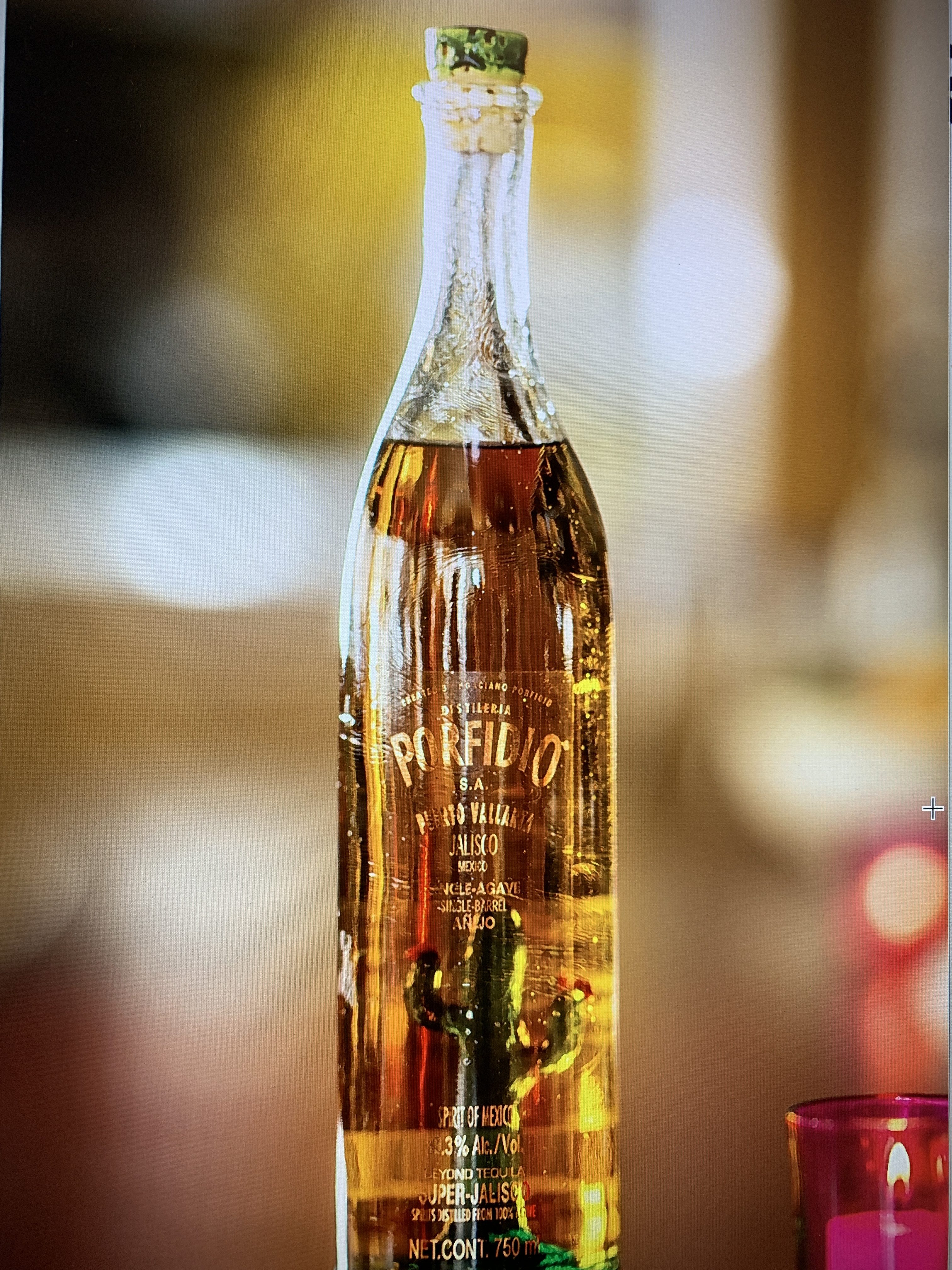The Arc From Porfidio to Mezcal: My Agave Journey Comes Full Circle
Many of you may know the storied tequila brand, Porfidio. While Patron may have been the first widely-marketed premium tequila sold in the US, there was nothing like Porfidio in the late ’90s to early 2000s. You might not remember the name, but you certainly remember the “Cactus Bottle”. It captured the imagination then and still brings a smile to my face today. It is a beautiful hand-blown glass bottle with a small, green, 2-inch tall, glass cactus sitting inside the bottle on the bottom. The cactus is like a little green guy waving “Hi. Come drink me.”
Initially, only the anejo existed so you had the gorgeous amber anejo working wonderfully in the clear bottle with the green cactus. I cannot believe I never saved even one empty bottle – what an idiot!
And this was a premium tequila because it cost about $100 even then. I first discovered it on a trip to Cozumel in the late ’90s. I was with the crew that still travels with me to Oaxaca every year, and we had just arrived at the Hotel Intercontinental in Cozumel. We saw the bottle behind the bar and knew we had to try it – and it was transcendent! We were already tequila drinkers but this was a new ballgame. Definitely a WTF moment.
Over the years, as more premium tequilas poured into the U.S. – and poured down our throats – Porfidio remained the standard bearer for us. Even though tequila drifted away for me and mezcal began to dominate my agave spirits consumption over 10 years ago, I’ve always known Porfido was my first love. Also, as I’ve met more people in the agave spirits world over the past ten years, I have come to learn there is a bit of controversy around my beloved Porfidio.
In the late ’90s and into the 2000s, there was a thread in the spirits industry questioning the provenance of Porfidio. Was it really tequila? Was it made in Jalisco? Speaking to Tequila.net, the founder of Porfidio, an Austrian named Martin Grassl, fueled the mystery as he spoke of European production techniques (“new world school”) and said he did not necessarily use highlands or lowlands agaves, but based his agave selection on “objective analytical quality” of the agaves – sounds fishy, right? So people were suspicious.
Happily, my friends and I knew nothing about this – we just loved the juice! Now, I really have not thought much about Porfidio over the past 10+ years, and I rarely drink tequila anymore. And you can still buy Porfidio – it’s expensive, though they’ve cheapened the look of that beautiful bottle, and I have no idea how it tastes anymore. But trust me when I tell you, 20 years ago, there was pure magic in that bottle.
Oaxaca 2019
Here is where my story comes back to mezcal (I am not sure I have ever written a story that does not start, finish, or come back to mezcal so I am not going to break my streak now). I go to Oaxaca with the boys every January, and we were there a few weeks ago. We had the good fortune of joining Asis Cortes at his family palenque in Santiago Matatlan on a Sunday afternoon. Asis is the face of El Jolgorio, Agave de Cortes, Nuestra Soledad and the 2018 release of Origen Raiz – an A. cenizo made in Durango. I’ve written a lot about Jolgorio as it is one of my favorite brands. Asis tells me that people suspect he is paying me! Not a chance. Early on, they gave me small 2oz samples of their mezcals, but other than that there has been no remuneration for Mezcal PhD. I simply love what they do. Back to the story….
We were at the family palenque and Asis’ father, Valentin, was working the palenque. The tahona (big stone wheel) was mashing cooked madrecuishe and Valentin was loading the mashed fibers

into a wheelbarrow and then lifting it into a fermentation vat. It is always amazing to see the time, effort and amount of physical exertion that goes into each step of mezcal making – this is hard work.
When Valentin had finished this part of the process, he sat down with Asis and all of us, and we started tasting mezcal. Going to a palenque is frequently filled with highlights, but it rarely gets better than an unhurried sit-down and tasting with the master mezcalero and his son. Here, the stories come out. The rich history of the family’s mezcal making past. The cultural significance of what mezcal means to them – in this case, they are Zapotec and, among many other things, mezcal is the way for them to connect with their ancestors. And the challenging times, which were not so long ago, when nobody wanted to buy mezcal. As the story turned to this difficult time for mezcal commerce, Valentin told us of an Austrian entrepreneur who came knocking in the late ’90s.
This gentleman had heard of the outstanding mezcals made by Valentin and his extended family in Matatlan, so he tracked down Valentin and his brother-in-law, Oscar Hernandez. He tasted the family products and wanted to strike a deal. Keep in mind, during this time, they did not have a well-known brand (no one really did then), and there was no certification process for mezcal yet either – that started in 2005. What little they did sell was largely for the immediate community. So an outsider who wanted to buy a lot of mezcal was a rare find.
But this fellow had a strange request: he only wanted to buy what was produced after the first distillation – he did not want the finished product. In this case, he wanted to buy a roughly 30% ABV espadin joven (an unaged mezcal made with agave espadin). While Valentin and Oscar, found this odd, they asked no questions and had the first batch ready in about a month. Over the first year or so, he regularly came to Oaxaca from his unknown origination point, and left with his mezcal in stainless steel containers, on his way to an unknown destination.
The second year, he had a different request: could they cook the pinas in aboveground ovens and remove the smokiness from the mezcal. Valentin and Oscar said they could accommodate this, but they had to build the oven. So they build an aboveground brick oven, which as you may know, is how artisanal tequila makers cook their pinas. This went on for a while longer and it was a good commercial relationship for Valentin and Oscar. But in the early 2000s, this gentlemen stopped coming, and they never heard from him again. While they were selling to him, the Cortes and Hernandez families never knew what he was doing with his once-distilled mezcal.
Some years later the mystery unraveled as they figured out what was going on through friends of friends. It was really pretty simple. This gentleman was taking the Cortes and Hernandez family mezcals to Jalisco, distilling it for a second and third time, and bottling it as a tequila. Apparently, he could not get the quality of spirit he wanted for his brand by using the blue agave from Jalisco, so he found his way down to Oaxaca to the palenques of Valentin and Oscar and bought their mezcal. But to halfway comply (though not really) with the tequila regulations, he had to distill it a second time in Jalisco and have the appearance of making his tequila there. Tequila was not regulated as tightly 20 years ago, so he could get away with it. Oh yeah, and did I mention the name of his tequila? You know it: Porfidio!
So Porfidio was actually a mezcal from Oaxaca, made from agave espadin, bottled as a tequila. The second distillation, which was done in Jalisco, did not change the provenance of the spirit – this was a mezcal made in Oaxaca. As Valentin told us this story over an amazing mezcal tasting at the family palenque, we could not believe what we were hearing. The tequila we were drinking in the late ’90s and early 2000s, Porfidio, which we worshipped, was actually made by the mezcalero sitting across from us in 2019, and it was not a tequila at all – it was mezcal!
I was stunned. Porfidio was my first love, and we had a difficult break-up as my love for mezcal grew. But in reality, I had never left her. She was a mezcal all along! Baby, I have come home!!
Maybe this was a “you had to be there moment” for you, but I hope not. When we first tasted Porfidio in the late ’90s, it was if we had discovered a Mayan treasure – it was pure gold! And to learn that it was actually being made at the time by one of the best mezcal producers in the world was a mind-blowing revelation!
Back to Porfidio
The founder of Porfidio referenced in this story is Martin Grassl. I have traded emails in the past with Martin, and he is a deeply passionate and educated producer of tequila. I am guessing he would dispute some or all of my story, and say that Porfidio was always made in Jalisco and never sourced in Oaxaca. Maybe not.
Porfidio can still be found today, though the packaging is not as elegant as it once was. As for the quality of the tequila, I really have no idea anymore. It’s still quite expensive, and I suspect it is still very good given the detailed exchanges I have had with Martin about his process, but I just don’t know. Next time I see it, I will certainly try it. Maybe I will even buy a bottle for old times sake (it might be the first bottle of tequila I’ve bought for myself in 10+ years).
That’s all I’ve got this time, and I hope you made it to the end. If you have a chance to drink El Jolgorio, Agave de Cortes, Nuestra Soledad or Origen Raiz, they are all made or orchestrated by the Cortes family and you cannot go wrong! As always, DRINK MEZCAL my friends.


